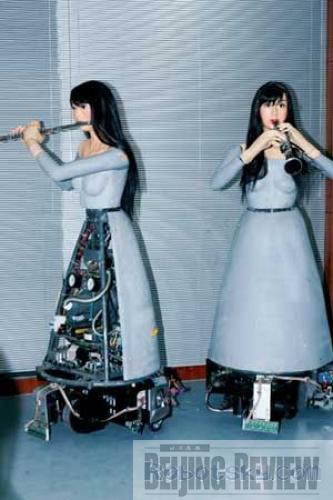|
 |
|
Playing Music: Beauty robots in the music band for the Shanghai Expo in 2010 (66WZ.com) | "The first robot in the band was cast as a cartoon shape playing the harp," Yang was quoted as saying by The Bund Pictorial. "In 2006, we developed robots shaped like real human beings, with more skillful performance. All members of the robot band at the Expo will be modeled as Chinese beauties."
The company hasn't decided yet whether the two robots at the lab will appear in the Expo band. They might also imitate the Twelve Girls Band, a well-known band that plays Chinese music with Chinese instruments.
It is easy for robots in the band to move around in all directions. They also have heightened intelligence, allowing them to communicate with visitors.
Kungfu robots
In addition to the band, robots embodying Chinese kungfu are also expected to show up at the Expo. They are as high as 1.7 meters, and equipped with 32 joints to help them move like real human beings.
"A robot comprehensively embodies various new and high technologies," said Yang. The kungfu robot is replete with technologies--its sound system is able to receive orders from man; a telecommunications system connects it with the Internet; sense organs help it to balance itself; and the 14 joints on its hands and feet enable it to turn 360 degrees, making it even more agile than human beings.
Wheelchair robots
The Institute of Robotics under Shanghai Jiao Tong University has been researching and developing intelligent wheelchairs for the Shanghai Expo, which are expected to be industrialized in the future, Chen Weidong, head of the Institute of Robotics, told China Business News.
"In addition to helping the disabled travel long distances at the Expo, the wheelchair robots are able to evade obstacles and communicate with people, thanks to equipment such as sense organs, controllers and cameras," said Chen.
"Certainly, you need to show robots around first, to familiarize them with the surroundings and the location of materials," said Chen. "If you show them the spot of a fridge, for example, they will remember and accurately show people the location from then on."
Communications between people and wheelchair robots will be a highlight at the Expo. The disabled can command them using speech and the hearing impaired can use sign language, while the seriously disabled can use brainwaves to command the robots, according to Wang Jingchuan, an associate research fellow at the Institute.
The Institute developed the brainwave-controlled wheelchair in cooperation with Tsinghua University. A disabled person using the chair will wear a helmet to collect brainwaves that, for example, will send the robot a "turn right" message at an intersection.
"Our goal is to make intelligent wheelchair robots for household use," Yang said. "We also hope to create a robot football team that can beat the world champions in 2050." | 